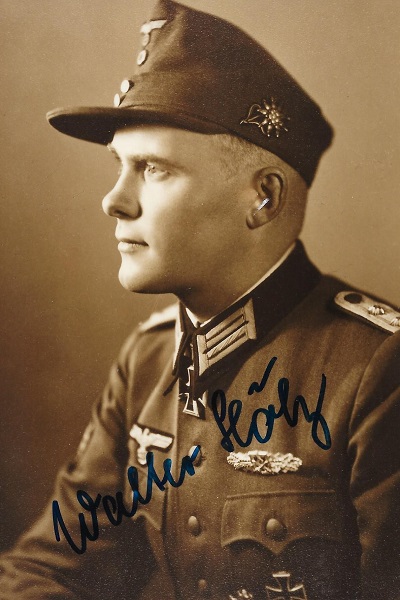Hölz, Walter
- Date of birth:
- February 22nd, 1914 (Schlattstall/Württemberg, Germany)
- Date of death:
- July 6th, 1994 (Beuren/Baden-Württemberg, Germany)
- Nationality:
- German
Biography
Walter Hölz finally reached the rank of Major.
Do you have more information about this person? Inform us!
- Period:
- Second World War (1939-1945)
- Rank:
- Hauptmann (Captain)
- Unit:
- Kommandeur III. / Gebirgsjäger-Regiment 98 / 1. Gebirgs-Division
- Awarded on:
- December 26th, 1944
“The Battle of Nagybajom:
For days the III./Gebirgs-Jäger-Regiment 98 defended the village of Nagybajom, south of Lake Balaton, against continual and powerful Russian attacks by forces far superior in men and materiel.
On the right - in the 8 km distant village of Kutas - was the II./Gebirgs-Jäger-Regiment 98, however no contact to German units existed on the left. Penetrations and encirclement attempts were eliminated via counterthrusts.
Early on the 08.12.1944, following an especially heavy artillery barrage, a very strong attack fell upon all positions of III. Bataillon.
Then a motorcycle messenger came back from an artillery liaison mission and reported that the road to Böhönje - the only supply route and the lifeline for the Bataillon - had been occupied by strong Russian forces 1 km west of Nagybajom. The Bataillon had been unknowingly bypassed during the night, and was now surrounded and with no communications to the outside.
Despite the powerful attacks against his Bataillon’s positions the commander - Hauptmann Hölz - resolved to immediately launch a counterthrust against the new enemy in his rear. All the still available reserves were immediately mobilized. They amounted to:
- 16 Jäger
- 12 Pioniere
- A messenger from the Bataillon staff, plus a doctor and a veterinarian
- 3 Sturmgeschütze that had been assigned to the Bataillon
Leader of the counterthrust: The commander himself.
Plan: All men would ride on the 3 Sturmgeschütze. They would try to make a swift drive towards the Russian positions, preferably dismounting within the positions themselves. By this the hope was to surprise, confuse and overpower the enemy.
Every man understood that the failure of this counterthrust would mean likely destruction for the Bataillon, which would in turn result in a decisive breakthrough for the Russians.
The plan was however successful!
Despite heavy fire the Kampfgruppe reached the positions of the enemy, who were dug in among the sandy soil, without loss. The emplaced enemy Pak and infantry guns were spotted and successfully engaged during the run-up of the Sturmgeschütze. The Jäger then leapt from their vehicles and in close combat cleared trench after trench, foxhole after foxhole. The Sturmgeschütze kept up with the Jägern and gave excellent, effective fire support.
The enemy suffered heavy losses. First individuals, and then many more Russians fled until the entire nearby wood was full of them. They left behind their entire complement of heavy weapons.
Thus a small group of determined Gebirgsjäger, under the leadership of their Bataillon commander and in exemplary cooperation with 3 Sturmgeschützen (which had already worked well with them in previous combat), was able to eject a Russian battalion that had been reinforced with heavy weapons out of their positions. With the flight of these enemies in the rear, the frontal attacks against Nagybajom were also called off.
Through this successful counterthrust the encirclement of the Bataillon was prevented, the supply road once again reopened and the breakthrough of the Russians into a nearly undefended hinterland averted.”
- Period:
- Second World War (1939-1945)
- Period:
- Second World War (1939-1945)
Sources
- Photo 1: Known to STIWOT
- - FELLGIEBEL, W.P., Elite of theThird Reich, Helion & Company Limited, Solihull, 2003.
- THOMAS, FRANZ & WEGMANN, GÜNTER, Die Ritterkreuzträger der Deutschen Wehrmacht 1939-1945.
- Axis History Biographical Research via Axis History Forum





